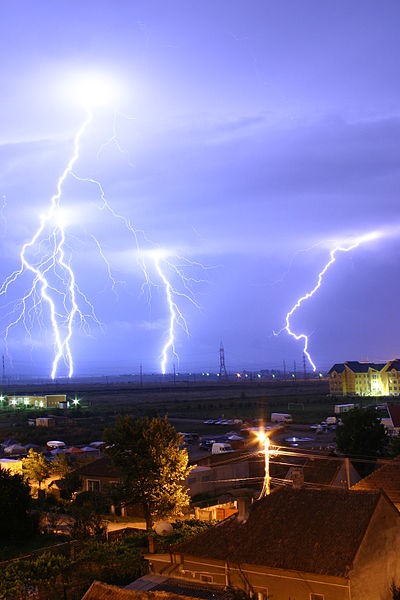Once, thunderstorms with thunder and lightning were interpreted as signs of the god’s wrath; nowadays, we are taught the mechanics behind a thunderstorm in school. You are probably already thinking about ice crystals that are smashed together by strong winds inside clouds, creating static charges in the process. How does a lightning bolt, though, find its way from the cloud to the ground? This question still keeps scientists awake at night – and there is still not a clear answer to how exactly the formation and movement of a lightning bolt work. This Question of the Month will give a brief summary on how a lightning bolt selects its target.
Lightning [1,2] occurs always when a large thunderstorm cloud with strong winds generates sufficient electrostatic charge that it must discharge towards the ground. The discharge itself occurs (simplified) in a twostep process, consisting of a main lightning bold and a preflash: The preflash travels as comparably weak (but still dangerous!) current downwards from the cloud. This usually happens in little jumps, which have been investigated with high-speed cameras. They show that the current path is apparently selected randomly by slowing down at a given position and then randomly selecting the next to jump to. This random selection appears to happen within a sphere of a few tens of meters in diameter around the tip of the growing lightning bolt. The process also involves growing many tendrils with individual tips and thus covers a large area (see also Fig. 1). With this procedure, the lightning bold eventually “feels” its way to the ground until it reaches it either directly or via a structure connected to it.

Therefore, if a conductive object reaches into such a sphere, the bolt will immediately jump to it and use it as a low-resistance shortcut to the ground – as a result, if possible, shortening the path for the discharge. This behavior leads to the curious effect of exclusion areas around structures that are protected with lightning rods, in which practically no ground strike will occur, and a person will not be hit directly. Unfortunately, this will not completely protect the person, as the electricity can still be dangerous within the ground.
Now that the preflash has found a path to the ground, the second phase starts, and the majority of the charge starts to flow with up to 20 000 A along the path found by the preflash. This is also the portion of the discharge that is visible by bare eye. It can consist of several distinct discharges that all follow the path of ionized air of the previous one, creating the characteristic flickering of a lightning bolt.
How the entire process from preflash to main discharge works is still not completely understood today and much of the presented insights were simply gathered phenomenologically by camera imaging. Additionally, there are many more types of and effects related to lightning bolts, which are relevant for our understanding of a variety of weather phenomena. All in all, thunderstorms are still something magical today, even if only figuratively.
— Kai Litzius
Further reading:
[1] http://stormhighway.com/cgdesc.php#part1
[2] https://what-if.xkcd.com/16/
[3] https://commons.wikimedia.org/wiki/File:Lightning_over_Oradea_Romania_2.jpg
[4] Chem. Unserer Zeit, 2019, 53. DOI: 10.1002/ciuz.201980045